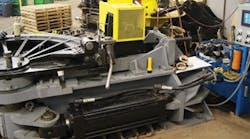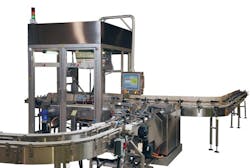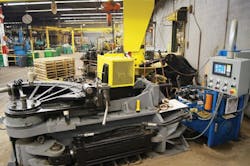Features that reduce a machine user's TCO are welcome, but how can machine builders justify the extra hit to the purchase price for some of these longer-term cost reductions? How do they sell the potential savings to their customers?
Cutting Energy Costs
The cost of running a machine has a huge impact on TCO, so energy consumption is an obvious target. "Robot suppliers are decreasing their products' overall power consumption," says Michael Gurney, principal at system integrator Concept Systems. "Since the tsunami in Japan caused the cost of power to increase, Japanese robot suppliers are updating their systems to do just as much with a lot less power consumption. For example, the Nachi SRA robot uses something like 20% less power relative to the previous generation. We see falling power requirements as a trend throughout all product offerings, but more so from Japan in the next decade."
A machine builder can monitor energy consumption with simple modules, notes Robert Muehlfellner, director of automation technology at B&R Industrial Automation. "For machines where the primary energy consumption is through servos, energy usage can be measured by the drive system directly," he explains. "With energy-consumption data available, every end user can take steps to optimize energy usage and reduce cost."
Another way that energy costs can be identified is with Profienergy, a function of Profinet. "One of the features of Profienergy is the ability to format data into useful information about energy demand," explains Carl Henning, deputy director of PI North America. "This information can be used to avoid demand peaks."
There are other benefits of monitoring. "Using devices with embedded intelligence to monitor motor currents, vibration and torque signatures allows machine builders to deliver machines with protective functions," notes Sandy Holden, market development manager of OEM business at Rockwell Automation. "These devices help guard against the damaging effects of electrical and other hazards, providing long-term equipment protection and, in turn, reduced cost of replacing equipment."
Hibernate If You Can
Some machine builders already offer a hibernation state. "Our machines only run when product is fed to the machine," says Derek Jones, marketing manager at Lantech, based in Louisville, Ky. "During downtime, the machine is not using much power at all. The cost to power down and power back up is greater than just leaving our machine in its automatic state."
Figure 1: This dual-infeed packaging machine accepts 350 granola bars per each of two sides. The bars are loaded into a single stream of top load cartons in different counts depending on retail requirements, and into bulk format cartons.
Propack Processing & Packaging Systems in Beamsville, Ontario, builds robotic collators to feed topload, endload and multipack packaging machines (Figure 1). Propack's machines typically run three shifts per day, says Chris Follows, president. "If no product is available, we turn off all the conveyors that feed the machine," he says. "This also ensures cartons are not damaged due to conveyor friction."
This raises an interesting point about machines operating smartly, notes Howard Dittmer, vice president of engineering and technology at Arpac, maker of packaging equipment in Schiller Park, Ill. "For the machine to make these decisions, other parts of the manufacturing process and their human operators need to adapt," he explains. "Manufacturers today put significant effort into maximizing the utilization of their capital investments. Running machines at an energy cost optimized for time-of-day utility pricing means there will be significant parts of the day when the machine isn't running."
This means energy-saving hibernation tactics require some analysis, such as determining when to shut the systems down to save energy. Such an analysis can go all the way from the plant floor to an ERP system. "To ensure a hibernation scheme is compatible with workflow and other production realities, I/O can transfer data to an ERP or MES," says Charlie Norz, product manager at Wago. "Integration with ERP will enable the entire organization to take a holistic approach to energy efficiency."
Adding a hibernate cycle can provide solid ROI, but monitoring motors is not the only way to save energy, agrees Darren Elliott, manager of global OEM technical resources at Rockwell Automation. "In an application that involves heating glue to seal a carton, a hibernate cycle can reduce the heat needed at different times of day, depending on production demands, saving tremendous amounts of energy and material," he explains.
You might not need to add special I/O, either. "Many end users might not realize their machines are equipped with features that automatically save energy," Elliott points out. "Drives can go into sleep mode automatically, allowing end users to save energy without an additional investment."
A recent study in the automotive industry quantified the savings possible by putting systems into a sleep, hibernate or standby mode when not actively producing value. "The analysis concluded that savings of up to 30% are possible," Henning says.
For all its potential, hibernation is not something to jump into without some thought. "Wago strongly suggests first integrating power measurement into the facility before tackling machinery," Norz says. "A bit of investment up front to determine the energy baseline will pinpoint the most urgent areas of attention. Avoiding a knee-jerk reaction to energy prices will enable you to find the best and quickest path to a solid ROI."
Automation Keeps Costs Down
While they reduce their customers' TCO, industrial OEMs still have to be price-competitive, and automation technology can help meet customer requirements at reasonable costs.
"Automation is a key ingredient in providing the flexibility that customers demand in our type of equipment," says Arpac's Dittmer. "Modern industrial controls allow us to produce core machine designs that we're able to customize to fit a wide range of applications (Figure 2)." The sidebar "Robotic Palletizer," p24, describes a typical Arpac system.
[sidebar id="2"]
"Automation can allow for more flexible designs, which can lead to standard designs that serve more customers," Gurney says. "For example, if an infeed can be modified through automation to be flexible to accommodate a 12 or 16 in. opening, this can become a standard single product, rather than having a 12 in. machine design and a 16 in. machine design."
"The very nature of automation has enabled builders to keep a handle on overall machine pricing," Norz says. "In general, automation prices have remained relatively stable despite features and capabilities rising sharply. The relative cost of automation actually is getting smaller, unlike mechanical components such as gears and linkages. Don't be surprised to see machine and robot controls representing a smaller portion of overall costs."
Follows says modern automation helps meet the needs of Propack's varied customers. "A consistent controls structure allows us to tailor each machine to the application," he says.
Upgrade Control Systems
One of the best ways to reduce TCO on an existing machine is to upgrade the control system. This eliminates the need to replace expensive machinery, which might consist of structural steel, motors, sensors, robots, conveyors and other systems.
That's what Industrial Technology Solutions (ITS), a system integrator in Columbus, Ohio, provides (Figure 3). Design engineer Brian Engle makes his living by updating older control systems. "If the equipment is not functional, then the manufacturer isn't making money," he says. "The advanced diagnostics and interfaces that automation can provide are, in my opinion, the best use of automation for an end user." For more on how ITS approaches a control system upgrade, see "Mechanical Machines Bending Horizontal."
Obsolete controls can wreak havoc on TCO because of poor operating efficiency, too much maintenance or too many shutdowns. Bill Savela, marketing manager at Delta Computer Systems, offers an example. "Our motion controller was used to retrofit a butterfly valve controller on an emissions control system for a rubber plant," he explains. "The plant used some high-speed valves that cycled often, and the cushions that the valves sealed against would often wear out, requiring the whole plant to be shut down while the cushions were replaced."
Perry Yoder at Oilquip, system integrator in Lake Charles, La., did the rubber plant upgrade. "Motion controllers were used to properly accelerate and decelerate the valves at high speed without causing impact of the valve seat at the end of stroke," he explains. The plant avoided what had been three shutdowns per year before the valve controls were replaced. In this case, the cost savings and subsequent reduction in TCO were very measurable.
Propack often upgrades the controls on its own machines. "We see great value in ensuring our customers have retrofit control upgrades, allowing the machines to be updated with new controls that are compatible with servo drives," Follows says.
Get Rid of the Shaft
Mechanical line shafts are another candidate for upgrading, and consequently cutting TCO. "Replacing mechanical line shafts with individual servos can greatly reduce the setup time of a machine," B&R's Muehlfellner says. "I recall a food-processing machine on which every product change took up to half a day to tweak mechanical cams of a line shaft for proper timing of the machine."
B&R replaced the mechanical line shaft and cams with individual servos. Now the timing is stored as a product recipe, and is recalled on a product change with the press of a button on the HMI. "The increased production flexibility and reduced downtime for the customer amortized the slightly higher initial hardware cost quickly," Muehlfellner says.
Arpac's Dittmer warns that if you take a design optimized for a pneumatic or a cam-driven mechanism and replace those functions with a servo, you're likely to increase the cost significantly. "However, if you optimize the new design to take advantage of the functionality offered by the servos, you can mitigate the cost adders," he says.
Adding automation technology to a basic process like line shafts, pneumatics or chain drives cuts TCO by reducing required maintenance. "We're upgrading a seed-packaging machine from a chain-drive system with interconnected timing gears and belts to a completely modular design using independent steppers and servo controllers from AutomationDirect for coordinated motion," Engle says. "The existing system is extremely difficult to adjust, as one adjustment leads to every other aspect of the process running at a different speed. Changing to steppers and servos will eliminate the problem."
Sell the Savings
The focused use of new technology to reduce a customer's total cost of machine operation seems like a no-brainer proposition. But how do OEMs overcome the oft-present resistance the customer has to the extra initial cost that sometimes accompanies new technology?
"We make a wide range of products with a wide range of costs and capabilities," Dittmer explains. "This is important because not all customers and their needs are created equal. We provide solutions that are tailored to those needs. The cost of the top-of-line machine is justified by the problem it solves for the customer that needs that solution."
Moving a customer from a manual task to one handled completely by the machine will always provide a positive ROI, Lantech's Jones says. "Using the customer's own numbers is the best way to show cost savings. By using their labor costs, they immediately see the potential savings in their own terms."
Engle likes the idea of using the customer's own data. "If a company tracks maintenance and equipment downtime, it's fairly simple to show payback," he says. "Most manufacturers feel comfortable with numbers coming off the equipment and can schedule accordingly. They demand a solution that will provide them the ability to minimize production loss and maximize profit. Automation does provide this solution, and can be proven to do so through their own collected data."
Show customers the financial justification, clearly stating the tangible and intangible benefits, Gurney advises. "We have had a lot of success with proof-of-concept demonstrations, where the customer provides a comparatively small investment and we use rapid prototyping tools to create a system that clearly demonstrates key elements of the solution," he says. "This allows the customer to better manage the political hurdles required to obtain a major change to their process."
Just don't go crazy with promoting new features. "All customers can benefit from some level of automation," Jones says. "The key is to not over-automate a customer. The level of automation must mesh well with the customer's level of sophistication."









